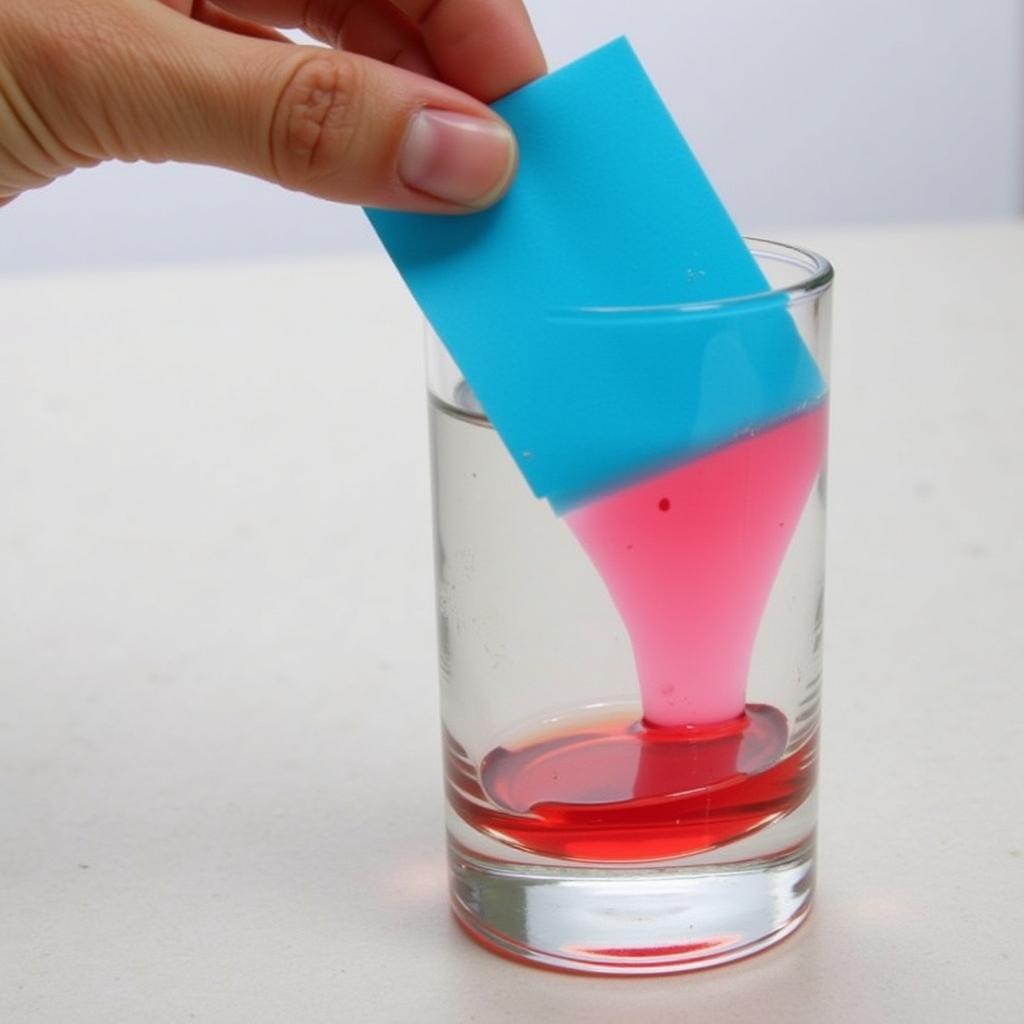Litmus paper is a common tool used to determine the acidity or basicity of a substance. So, what color does acid turn litmus paper? The answer is red. Understanding this color change, and what causes it, is fundamental to grasping the basics of pH and chemical indicators.
If you dip blue litmus paper into an acidic solution, it will change from blue to red. This simple test is widely used in classrooms, laboratories, and even at home for tasks like testing soil pH. But why does this color change happen, and what does it signify about the chemical properties of the solution being tested? Let’s delve deeper into the science behind this fascinating phenomenon. You might also be interested to know what color litmus paper turns in a base.
Understanding Litmus Paper and Acids
Litmus paper is made from dyes extracted from lichens. These dyes are sensitive to changes in pH, meaning they change color depending on whether a solution is acidic, basic (also called alkaline), or neutral. Acids are substances that release hydrogen ions (H+) when dissolved in water. The higher the concentration of hydrogen ions, the stronger the acid and the lower the pH. Acids typically have a sour taste and can react with metals. Knowing what color does acid turn litmus helps categorize and understand various substances.
How the Color Change Occurs
The color change of litmus paper is a result of a chemical reaction between the litmus dye and the hydrogen ions present in the acid. The litmus dye molecules have a specific structure that changes when exposed to a sufficient concentration of hydrogen ions. This structural change alters the way the dye absorbs and reflects light, leading to the visible color shift from blue to red. The intensity of the red color can also indicate the strength of the acid – a darker red typically signifies a stronger acid.
 Litmus Paper Color Change in Acid
Litmus Paper Color Change in Acid
Common Examples of Acids and Their Effect on Litmus Paper
Many common household substances are acidic and will turn blue litmus paper red. These include:
- Lemon juice: Citric acid in lemon juice is responsible for its sour taste and its ability to turn litmus paper red.
- Vinegar: Acetic acid is the key component of vinegar and causes the red color change in litmus paper.
- Orange juice: Like lemons, oranges contain citric acid, which will turn litmus paper red. To see how it interacts with litmus already changed by another substance, it’s insightful to learn what color would litmus paper red turn in orange juice.
- Soda drinks: Carbonic acid gives soda its fizz and acidic properties, resulting in the red litmus paper color change.
Dr. Maria Sanchez, a renowned chemist, explains:
“The litmus test is a quick and easy way to identify an acidic substance. The distinct change in color from blue to red is a clear visual indicator of the presence of hydrogen ions.”
What if the Litmus Paper Doesn’t Turn Red?
If blue litmus paper doesn’t turn red when dipped into a solution, it doesn’t necessarily mean the solution is not acidic. It could simply mean that the acid is very weak and doesn’t produce enough hydrogen ions to trigger the color change. Alternatively, the solution could be neutral or basic (alkaline). To test for basicity, you would use red litmus paper, which turns blue in the presence of a base. It’s beneficial to learn what color does litmus paper turn in nuetral to fully understand the spectrum of litmus reactions.
Conclusion
So, to reiterate, what color does acid turn litmus paper? The answer is red. This simple color change is a fundamental concept in chemistry and is a useful tool for quickly identifying acidic substances. Knowing the principles behind this reaction allows us to understand the properties of different solutions and their impact on our environment. Understanding the color change of litmus paper, especially what color do bases turn litmus paper, provides a complete picture of how this indicator works.
FAQ
- What is the pH range for acids? Acids have a pH less than 7.
- Can red litmus paper be used to test for acidity? No, red litmus paper is used to test for bases. It turns blue in the presence of a base.
- Are all acids dangerous? No, not all acids are dangerous. Many weak acids are found in everyday foods.
- What is a neutral solution? A neutral solution has a pH of 7, like pure water.
- Besides litmus paper, what other methods can be used to test pH? pH meters and other chemical indicators can also be used to measure pH.
- Why does the intensity of the red color vary? The intensity of the red color can indicate the strength of the acid.
- Where can I buy litmus paper? Litmus paper can be purchased online, at scientific supply stores, and some educational bookstores.
Common situations where this question arises:
- Science classes during experiments
- Testing soil pH for gardening
- Checking the acidity of pool water
- Identifying unknown substances in a laboratory setting
Related Topics to Explore:
- pH scale
- Acid-base reactions
- Chemical indicators
- Properties of acids and bases
Need support? Contact us at Phone Number: 0373298888, Email: [email protected] or visit us at 86 Cau Giay, Hanoi. We have a 24/7 customer service team.

